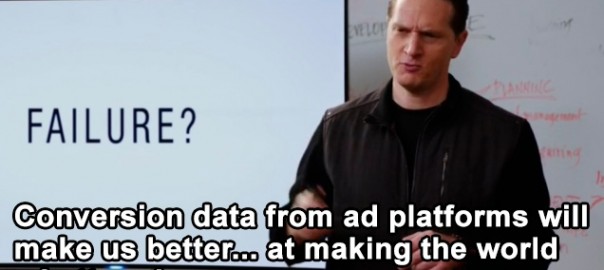Marketers get online conversion data from every advertising platform they use. This creates a need for a third party platform to help marketers measure online conversion data coming from multiple platforms.
Without the ability to distinguish which prospects converted, and when the conversion happened, marketers can’t see what’s happening in their marketing funnels.
This inability to see what’s really happening, is a situation captured by the character Gavon Belson in the HBO comedy series, Silicon Valley.
Gavon Belson is the head of Hooli, a fictional tech company in same vein as Yahoo or Microsoft. He hangs out with his spiritual advisor who reaffirms Gavon’s beliefs, supporting all his ideas no matter how shallow or dim-witted.

Gavon’s dev team promises innovation and reports satisfactory progress. Unfortunately, the team ends up creating products that are Windows Vista and Apple Maps bad.
Wondering how this happened, he asks his spiritual guru, “Have I just surrounded myself with sycophants who are just telling me whatever I want to hear, regardless of the truth?”
His spiritual advisor gulps, “Nooo….”
Gavon believes his spiritual advisor and is unable to see the disaster that is happening. Relying on out-of-the-box online conversion data alone leads to the same thing: the inability to see what’s really happening.
How leads progress through the funnel, from first-touch to lead created, simply can’t be known using Adwords conversion click data. Nor can it be done using conversion data from Twitter and Facebook. Using conversion data from these platforms leads to a variety of problems:
- marketers double count leads
- touchpoints are sequenced incorrectly
- attribution models are unreliable
Let’s look at this in more detail.
What Online Conversion Data Can and Can’t Do
First let’s review how Google calculates Adwords converted clicks. A converted click is an AdWords ad click resulting in one or more conversions.
In AdWords you can count the total number of converted clicks, and count the total number of conversions. One converted click can result in multipled conversions if it happens in the same session. For example, they downloade multiple ebooks after clicking on your ad.
You can also report unique conversions. A unique conversion is when a person generates multiple leads, e.g. filling out multiple forms.
AdWords counts the converted click as long as a conversion happens within 30 days after a click is tracked.
There are some important details to remember when using AdWords converted clicks:
- You can’t segment the Converted clicks by conversion name or category, because each ad click can lead to multiple conversions. If you were to segment by conversion name, some converted clicks could be counted more than once, and your segmented converted clicks would add up to more than the total.
- Conversions that happen 30 days after the initial click aren’t tracked.
Next, I’ll illustrate how reporting can become confusing when combining conversion data with ad platforms like Twitter and Facebook.
Understanding the Marketing Funnel With Accurate Conversion Data
Let’s say we have three leads who each have a different path through the funnel. They discover your brand (first click), engage (middle touch) and become a lead (last touch). We illustrate each touchpoint for our leads below.

When marketers measure conversions by aggregating data from multiple ad platforms, they end up double counting. And there is no way to know which converted click is the first touch or last touch.
Based on the the same example above, you’ll see how total conversions get miscounted in the chart below.

If marketers can’t see conversion data clearly, they can’t see performance.
Marketers want to know how many leads they generated, when the first and last touch happens, and what channels leads come from — marketers can’t do this if conversion clicks are miscounted and misapplied to leads.
Performance relies on attributing revenue to conversions accurately. In B2B sales cycles, identifying when leads engage, which keywords, ad content, and channels they engage with, provides answers to the big questions in online marketing:
- Where do leads come from?
- Which campaigns are producing revenue?
- Which channels are generating customers?
In Silicon Valley the tech CEO can’t get an accurate picture of his team and their performance, until it’s too late. It plays out accordingly, he attends a focus group and finds that every user has one opinion: the product is a massive flub.
Relying on performance data from vendors is the equivalent of hiring a yes-man to give you honest feedback. Gettting a second opinion via an attribution solution takes the confusion out of measuring performance and online conversions.
(172)





